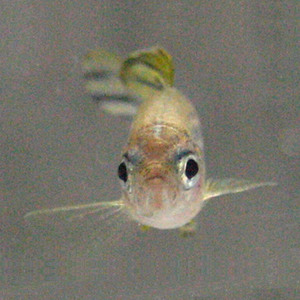Jul. 17, 2009 Research Highlight Biology
Sense of attraction
Researchers identify a population of olfactory sensory neurons that is responsible for zebrafish attraction towards amino acids
 Figure 1: A zebrafish searching for food.
Figure 1: A zebrafish searching for food.
Many olfactory cues pervade the aquatic environment of fish. These cues stimulate various important behaviors, such as escape from predators, or attraction towards food sources or potential mates.
Amino acids are the building blocks of proteins, and are therefore key nutrients in the diet of various animal species, including the zebrafish (Fig. 1). Now, a group of scientists led by Yoshihiro Yoshihara and Tetsuya Koide at the RIKEN Brain Science Institute in Wako has elucidated which neurons are responsible for carrying olfactory information about amino acids in the aquatic environment from the nose to the brain of zebrafish. They found that the activity of these neurons is required to elicit zebrafish attraction towards amino acids in their environment1.
Olfactory sensory neurons (OSNs) project from the nose to the olfactory bulb, which is the first relay station for olfactory information in the brain. Each OSN expresses only one type of odorant receptor and responds to a particular set of closely related odors. The OSNs that express the same odorant receptor send their axons together to a specific part of the olfactory bulb.
Yoshihara and colleagues used genetic approaches to express a fluorescent protein in various populations of OSNs. They found that only one of these populations projected to the lateral part of the olfactory bulb, which is known to fire in response to amino acid signals.
When hungry zebrafish were placed into a tank of water with amino acids pumped into one corner, the fish tended to spend more time in the portion of the tank near the amino acids. This suggests that zebrafish are attracted towards the amino acids as a potential source of food. When the researchers blocked synaptic transmission in the population of OSNs that projected to the lateral olfactory bulb, this blocked the so-called ‘attractive behavior’ of the zebrafish towards the amino acids. Blocking synaptic transmission in other populations of OSNs had no effect on this behavior, but did reduce attractive responses of zebrafish to a putative social pheromone in the environment.
According to Yoshihara, “a combination of genetic, anatomical, and behavioral approaches enabled us to provide a direct functional link between different odor inputs and distinct behavioral outputs through segregated olfactory neural circuits from the nose to the brain.” Using similar approaches, Yoshihara says that he and his colleagues “are now investigating neural circuit mechanisms underlying other olfactory behaviors such as escape from predators and memory of mates or related individuals.”
References
- 1. Koide, T., Miyasaka, N., Morimoto, K., Asakawa, K., Urasaki, A., Kawakami, K. & Yoshihara, Y. Olfactory neural circuitry for attraction to amino acids revealed by transposon-mediated gene trap approach in zebrafish. Proceedings of the National Academy of Sciences USA, 106, 9884-9889 (2009). doi: 10.1073/pnas.0900470106
